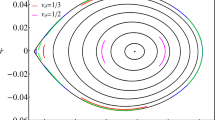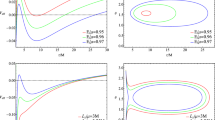Abstract
The largest part of any gravitational-wave inspiral of a compact binary can be understood as a slow, adiabatic drift between the trajectories of a certain referential conservative system. In many contexts, the phase space of this conservative system is smooth, and there are no “topological transitions” in the phase space, meaning that there are no sudden qualitative changes in the character of the orbital motion during the inspiral. However, in this chapter, we discuss the cases where this assumption fails and nonlinear and/or non-smooth transitions come into play. In integrable conservative systems under perturbation, topological transitions suddenly appear at resonances, and we sketch how to implement the passage through such regions in an inspiral model. Even though many of the developments of this chapter apply to general inspirals, we focus on a particular scenario known as the extreme mass ratio inspiral (EMRI). An EMRI consists of a compact stellar-mass object inspiraling into a supermassive black hole. At leading order, the referential conservative system is simply geodesic motion in the field of the supermassive black hole, and the rate of the drift is given by radiation reaction. In Einstein gravity, the supermassive black hole field is the Kerr spacetime in which the geodesic motion is integrable. However, the equations of motion can be perturbed in various ways so that prolonged resonances and chaos appear in phase space as well as the inspiral, which we demonstrate in simple physically motivated examples.
Access this chapter
Tax calculation will be finalised at checkout
Purchases are for personal use only
Similar content being viewed by others
References
Amaro-Seoane P, Audley H, Babak S et al (2017) Laser interferometer space antenna. arXiv:1702.00786
Arnold V, Kozlov V, Neishtadt A (2006) Mathematical aspects of classical and celestial mechanics, 3rd edn. Springer International Publishing
Arnold VI (1963) Proof of a Theorem of A. N. Kolmogorov on the invariance of quasi-periodic motions under small perturbations of the Hamiltonian. Russ Math Surv 18(5):9–36
Bambi C (2011) Testing the Kerr black hole hypothesis. Mod Phys Lett A 26(33):2453–2468
Banks J, Brooks J, Cairns G et al (1992) On Devaney’s definition of chaos. Am Math Mon 99(4):332–334
Barack L, Pound A (2019) Self-force and radiation reaction in general relativity. Rep Prog Phys 82(1):016904
Barausse E, Berti E, Hertog T et al (2020) Prospects for fundamental physics with LISA. Gen Relativ Gravit 52(8):81
Basovník M, Semerák O (2016) Geometry of deformed black holes. II. Schwarzschild hole surrounded by a Bach-Weyl ring. Phys Rev D 94(4):044007
Berry CPL, Cole RH, Cañizares P, Gair JR (2016) Importance of transient resonances in extreme-mass-ratio inspirals. Phys Rev D 94:124042
Bičák J, Ledvinka T (1993) Relativistic disks as sources of the Kerr metric. Phys Rev Lett 71(11):1669–1672
Birkhoff GD (1913) Proof of Poincaré’s geometric theorem. Trans Am Math Soc 14(1):14–22
Brink J, Geyer M, Hinderer T (2015) Astrophysics of resonant orbits in the Kerr metric. Phys Rev D 91:083001
Brink J, Geyer M, Hinderer T (2015) Orbital resonances around black holes. Phys Rev Lett 114(8):081102
Carter B (1968) Global structure of the Kerr family of gravitational fields. Phys Rev 174(5):1559–1571
Carter B (1968). Hamilton-Jacobi and Schrödinger separable solutions of Einstein’s Equations. Commun Math Phys 10(4):280–310
Contopoulos G (2004) Order and chaos in dynamical astronomy. Springer Science & Business Media
Destounis K, Suvorov AG, Kokkotas KD (2020) Testing spacetime symmetry through gravitational waves from extreme-mass-ratio inspirals. Phys Rev D 102:064041
Destounis K, Suvorov AG, Kokkotas KD (2021) Gravitational-wave glitches in chaotic extreme-mass-ratio inspirals. arXiv e-prints, page arXiv:2103.05643
Dixon WG (1974) Dynamics of extended bodies in general relativity. III. Equations of motion. Philos Trans R Soc Lond Ser A 277(1264):59–119
Doroshkevich A, Zel’Dovich YB, Novikov I (1966) Gravitational collapse of nonsymmetric and rotating masses. Sov Phys JETP 22:122–30
Efthymiopoulos C, Contopoulos G, Voglis N, Dvorak R (1997) Stickiness and cantori. J Phys A Math Gen 30(23):8167–8186
Eleni A, Apostolatos TA (2020) Newtonian analogue of a Kerr black hole. Phys Rev D 101(4):044056
Flanagan ÉÉ, Hinderer T (2012) Transient resonances in the inspirals of point particles into black holes. Phys Rev Lett 109(7):071102
Flanagan EE, Hughes SA, Ruangsri U (2014) Resonantly enhanced and diminished strong-field gravitational-wave fluxes. Phys Rev D 89:084028
Frolov VP, Krtouš P, Kubizňák D (2017) Black holes, hidden symmetries, and complete integrability. Living Rev Relativ 20(1):6
Grobman DM (1959) Homeomorphisms of systems of differential equations. Dokl Akad Nauk SSSR 128:880–881
Hansen RO (1974) Multipole moments of stationary space-times. J Math Phys 15(1):46–52
Hartman P (1960) A lemma in the theory of structural stability of differential equations. Proc Am Math Soc 11(4):610–620
Hu W-R, Wu Y-L (2017) The Taiji Program in Space for gravitational wave physics and the nature of gravity. Natl Sci Rev 4(5):685–686
Isoyama S, Fujita R, Nakano H et al (2013) Evolution of the carter constant for resonant inspirals into a Kerr black hole: I. The scalar case. Progress Theoretical Exp Phys 2013(6):063E01
Isoyama S, Fujita R, Nakano H et al (2019) “flux-balance formulae” for extreme mass-ratio inspirals. Progress Theoretical Exp Phys 2019(1):013E01
Johannsen T (2013) Regular black hole metric with three constants of motion. Phys Rev D 88(4):044002
Kerr RP (1963) Gravitational field of a spinning mass as an example of algebraically special metrics. Phys Rev Lett 11(5):237–238
Kevorkian JK, Cole JD (2012) Multiple scale and singular perturbation methods, volume 114. Springer Science & Business Media
Kolmogorov AN (1954) On the conservation of conditionally periodic motions under small perturbation of the Hamiltonian. Dokl Akad Nauk SSSR 98:527–530
Lemos JPS, Letelier PS (1994) Exact general relativistic thin disks around black holes. Phys Rev D 49(10):5135–5143
Lukes-Gerakopoulos G, Apostolatos TA, Contopoulos G (2010) Observable signature of a background deviating from the Kerr metric. Phys Rev D 81:124005
Lukes-Gerakopoulos G, Katsanikas M, Patsis PA, Seyrich J (2016) Dynamics of a spinning particle in a linear in spin Hamiltonian approximation. Phys Rev D 94(2):024024
Lynden-Bell D (2000) Carter separable electromagnetic fields. Mon Not R Astron Soc 312(2):301–315
Manko VS, Novikov ID (1992) Generalizations of the Kerr and Kerr-Newman metrics possessing an arbitrary set of mass-multipole moments. Class Quan Grav 9(11):2477–2487
Manko VS, Sanabria-Gómez JD, Manko OV (2000) Nine-parameter electrovac metric involving rational functions. Phys Rev D 62(4):044048
Markakis C (2014) Constants of motion in stationary axisymmetric gravitational fields. Mon Not R Astron Soc 441(4):2974–2985
Mathisson M (1937) Neue mechanik materieller systemes. Acta Phys Polon 6:163–2900
Miller J, Pound A (2020) Two-timescale evolution of extreme-mass-ratio inspirals: waveform generation scheme for quasicircular orbits in Schwarzschild spacetime. arXiv preprint arXiv:2006.11263
Mino Y (2003) Perturbative approach to an orbital evolution around a supermassive black hole. Phys Rev D 67(8):084027
Morbidelli A (2002) Modern celestial mechanics: aspects of solar system dynamics, 1st edn. CRC Press
Moser J (1962) On invariant curves of area-preserving mappings of an annulus. Nachrichten der Akademie der Wissenschaften in Göttingen. II. Mathematisch-Physikalische Klasse, pp 1–20
Neugebauer G, Meinel R (1993) The Einsteinian gravitational field of the rigidly rotating disk of dust. Astrophys J Lett 414:L97
Papapetrou A (1951) Spinning test particles in general relativity. 1. Proc R Soc Lond A209:248–258
Pesin YB (1977) Characteristic Lyapunov exponents and smooth ergodic theory. Russ Math Surv 32(4):55–114
Poincaré H (1912) Sur un théorème de géométrie. Rendiconti del Circolo Matematico di Palermo 33:375–407
Poincaré H (1993) New methods of celestial mechanics. American Institute of Physics, Woodbury
Poisson E, Pound A, Vega I (2011) The motion of point particles in curved spacetime. Living Rev Relativ 14(1):7
Polcar L, Semerák O (2019) Free motion around black holes with discs or rings: Between integrability and chaos. VI. the Melnikov method. Phys Rev D 100(10):103013
Rüdiger R (1981) Conserved quantities of spinning test particles in general relativity. I. Proc R Soc Lond A 375(1761):185–193
Rüdiger R (1983) Conserved quantities of spinning test particles in general relativity. II. Proc R Soc Lond A 385(1788):229–239
Sano Y, Tagoshi H (2014) Gravitational perturbation induced by a rotating ring around a Kerr black hole. arXiv preprint arXiv:1412.8607
Semerák O (2003) Gravitating discs around a Schwarzschild black hole: III. Class Quan Grav 20(9):1613–1634
Semerák O, Suková P (2010) Free motion around black holes with discs or rings: between integrability and chaos–I. Mon Not R Astron Soc 404(2):545–574
Semerák O, Čížek P (2020) Rotating disc around a Schwarzschild black hole. Universe 6(2):27
Semerák O, Suková P (2015) On geodesic dynamics in deformed black-hole fields. Fund Theor Phys 179:561–586
Silverman S (1992) On maps with dense orbits and the definition of chaos. Rocky Mt J Math 22(1):353–375
Smale S (1965) Diffeomorphisms with many periodic points. In: Cairns SS (ed) Differential and combinatorial topology: a symposium in honor of Marston Morse. Princeton University Press
Speri L, Gair JR (2021) Assessing the impact of transient orbital resonances. arXiv e-prints, page arXiv:2103.06306
Suzuki S, Maeda K-I (1997) Chaos in Schwarzschild spacetime: the motion of a spinning particle. Phys Rev D 55(8):4848–4859
van de Meent M (2014) Conditions for sustained orbital resonances in extreme mass ratio inspirals. Phys Rev D 89(8):084033
van de Meent M (2014) Resonantly enhanced kicks from equatorial small mass-ratio inspirals. Phys Rev D 90(4):044027
Van De Meent M (2018) Gravitational self-force on generic bound geodesics in Kerr spacetime. Phys Rev D 97(10):104033
Vigeland S, Yunes N, Stein LC (2011) Bumpy black holes in alternative theories of gravity. Phys Rev D 83(10):104027
Witzany V (2019) Hamilton-Jacobi equation for spinning particles near black holes. Phys Rev D 100(10):104030
Witzany V, Semerák O, Suková P (2015) Free motion around black holes with discs or rings: between integrability and chaos–IV. Mon Not R Astron Soc 451(2):1770–1794
Witzany V, Steinhoff J, Lukes-Gerakopoulos G (2019) Hamiltonians and canonical coordinates for spinning particles in curved space-time. Class Quan Grav 36(7):075003
Zelenka O, Lukes-Gerakopoulos G, Witzany V, Kopáček O (2020) Growth of resonances and chaos for a spinning test particle in the Schwarzschild background. Phys Rev D 101(2):024037
Acknowledgements
GL-G has been supported by the fellowship Lumina Quaeruntur No. LQ100032102 of the Czech Academy of Sciences. VW was supported by European Union’s Horizon 2020 research and innovation program under grant agreement No 894881. The authors would like to thank Lukáš Polcar for allowing them to use the didactic example in section “External Matter Deformation”.
Author information
Authors and Affiliations
Editor information
Editors and Affiliations
Rights and permissions
Copyright information
© 2022 Springer Nature Singapore Pte Ltd.
About this entry
Cite this entry
Lukes-Gerakopoulos, G., Witzany, V. (2022). Nonlinear Effects in EMRI Dynamics and Their Imprints on Gravitational Waves. In: Bambi, C., Katsanevas, S., Kokkotas, K.D. (eds) Handbook of Gravitational Wave Astronomy. Springer, Singapore. https://doi.org/10.1007/978-981-16-4306-4_42
Download citation
DOI: https://doi.org/10.1007/978-981-16-4306-4_42
Published:
Publisher Name: Springer, Singapore
Print ISBN: 978-981-16-4305-7
Online ISBN: 978-981-16-4306-4
eBook Packages: Physics and AstronomyReference Module Physical and Materials ScienceReference Module Chemistry, Materials and Physics




